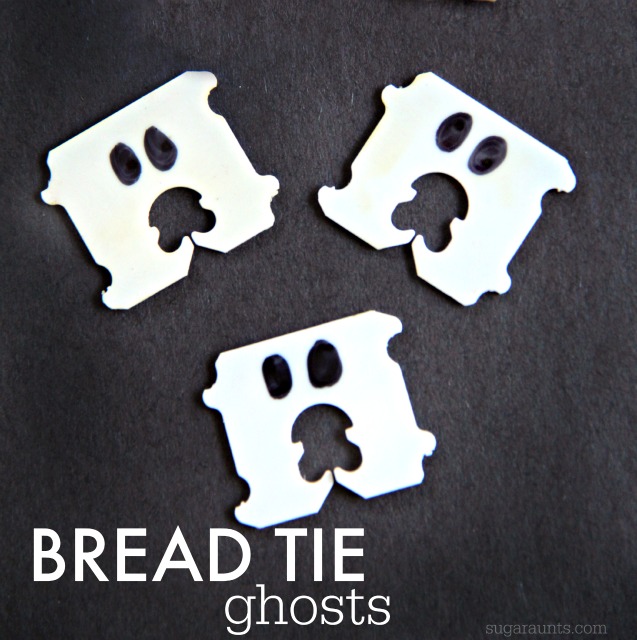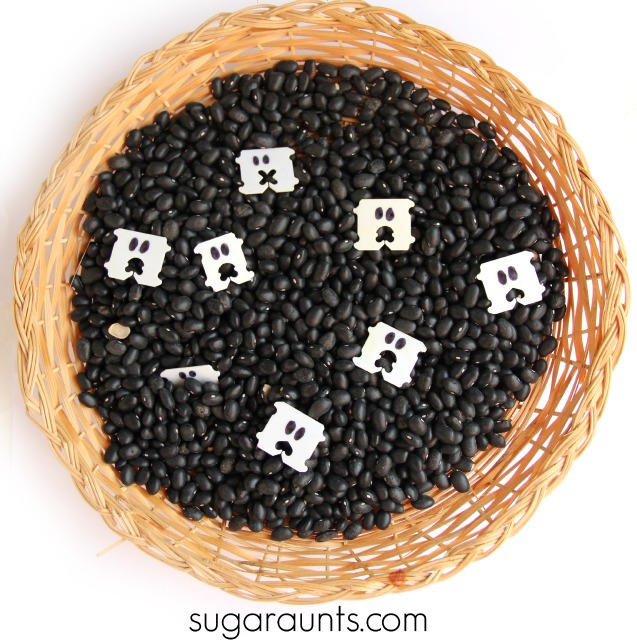This Halloween Ghost craft was so beyond easy to throw together. I tend to save a little bit of everything to use in play, crafts, and fine motor/sensory/movement activities and use them in occupational therapy halloween crafts to work on a variety of areas with a fun fall theme. We have a pile of these plastic bread ties that I’ve been saving for a fun craft or learning activity. Today, we made an easy ghost craft with them and used these cutie pie ghosts in a tactile sensory exploration play. For another ghost craft that can be used at Halloween parties for kids or in OT this season, try this easy ghost craft that works on scissor skills or this recycled container ghost craft.
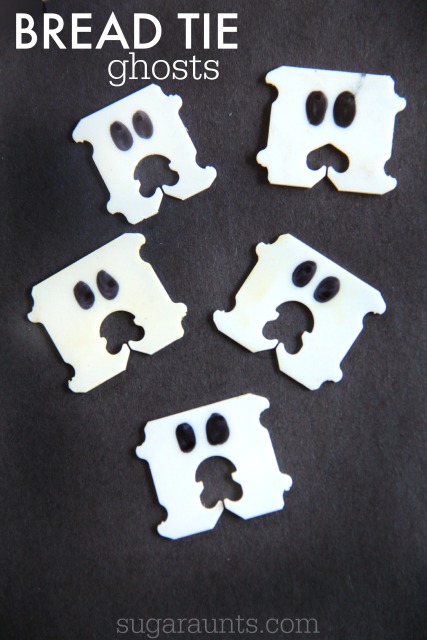
Ghost Craft for Kids
To make the bread tie ghosts, you’ll need just two items: (We’re including affiliate links in this post.)
These ghosts are just one way to use recycled materials in kids crafts.
Plastic Bread ties (you can save these from loaves of bread, bagels, and other grocery items.
A black permanent marker
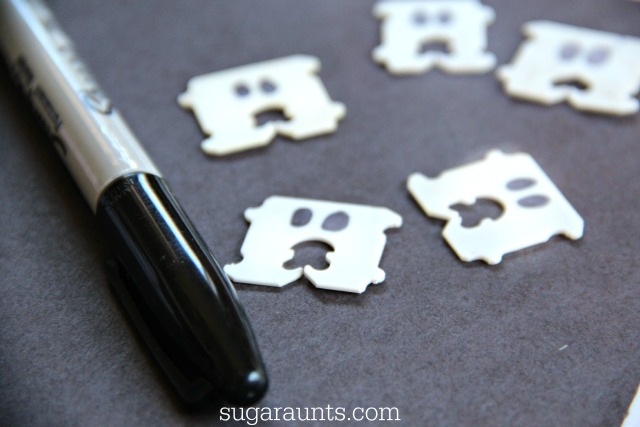
Simply draw on eyes for each ghost. Done! Kids will like making this simple ghost craft and using them in sensory or fine motor play.
Fill a bowl with a sensory bin filler. We used dry black beans, but you could use any material. Some ideas are shredded paper, dyed rice, pumpkin seeds, dry split peas, cotton balls, or sand. The options are limitless. Ask your child for ideas, too. They probably have some some ideas that you might not have thought of!
Sensory bins and sensory play is important in discovery of materials, tactile exploration, and learning how a child’s environment works together. Not only that, but simple sensory bins like the one we made can encourage language development, self-confidence, and work on tactile defensiveness in kiddos. (This post is part of our 31 Days of OT series where I’m sharing free or almost free materials in Occupational Therapy activities.)
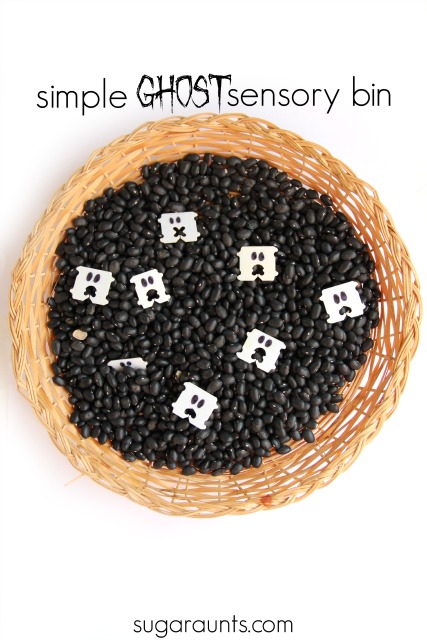
Ghost Sensory Bin
Sensory bins allow a child to explore textures through play. Discover, explore, and inspire creativity with a simple sensory bin like this ghost and bean bin. In Occupational Therapy settings, therapists might use a sensory bin like this to provide a calming period in a sensory diet or lifestyle. A sensory bin provides an opportunity for the body to slow down, much like a sensory bottle. It can be relaxing for a child who is overstimulated or hypersensitive to his or her environment. Some kids do not prefer to touch materials that are sticky, squishy, scrapey, or tickly. A sensory bin can allow a child to explore these textures and more in a confined area (a box, bin, bowl, or baby pool are some ideas.) Other kids who are easily overstimulated in their environment can benefit from a sensory play like a sensory bin be exploring the textures and getting a chance to calm down. Sensory bins can be small and perfect for hand activities, or big enough to hold the whole child. Another benefit of a sensory bin in therapy and play is that you can customize them to fit the needs of your child/children: Fine motor, visual motor, tool use, bilateral hand coordination, gross motor skills, and even learning objectives can be added to sensory bins.
Sensory play in sensory bins is a great way to encourage a “just right” sensory level as part of a sensory diet. Kids can benefit from sensory bin play to challenge sensory processing, to fidget, more, or help with self-regulation. Here is more information on how to create a sensory diet.
For more information on tactile sensory play this time of year, try our list of Fall Tactile Activities.
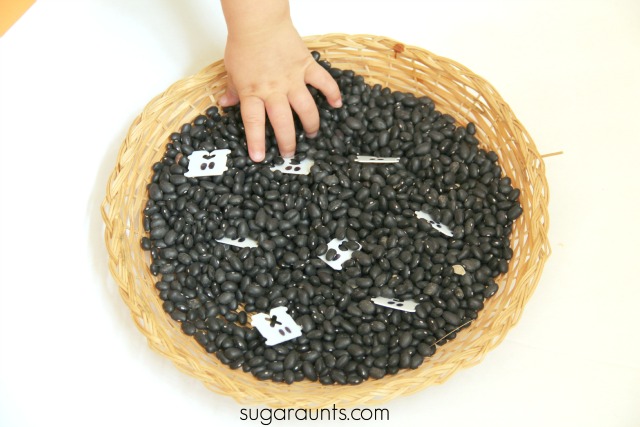
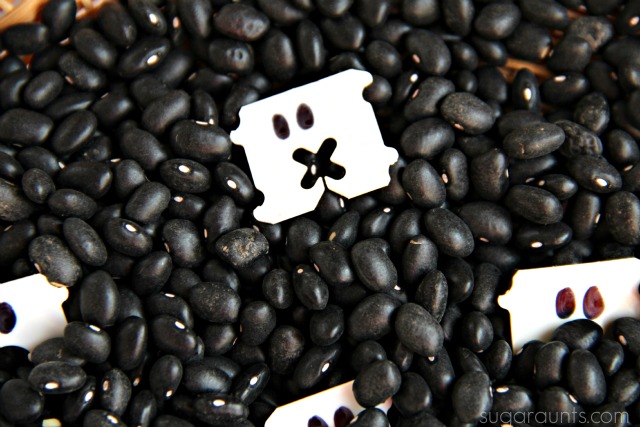
Sensory Bin Items for Learning and Play
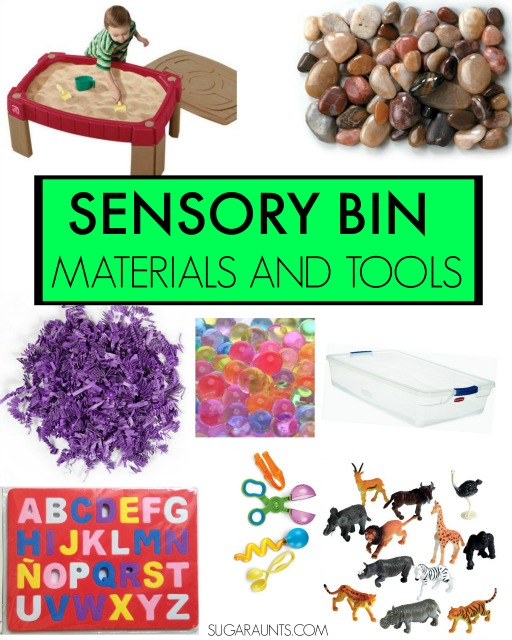
These are some items you might want to include in your sensory bins for a filler, manipulation, leaning, and exploring. These are just some ideas to get you started, and only the beginning of sensory bin play! The awesome thing about sensory bins is that they can be customized according to the child’s needs and interests and so, there are limitless ways to set up and play with a sensory bin!
Sensory bins are a great way to practice fine motor skills. No matter what your learning objective is (or maybe it’s just simple play!), these fine motor tool set
can be used in so many sensory bins for scooping, tweezing, dropping, and dumping!
So what do you put your sensory bin IN? We love our Sand Table
We use our sand and water tables often in sensory bin play, but many times we use a Under the bed storage bin
Natural River Rocks
Shredded Paper
Animal figures
I love this Alphabet Puzzle
Are you looking for more information on Sensory Processing, creating a sensory diet, or understanding the body’s sensory systems and how they affect functional skills and behavior? This book, The Sensory Lifestyle Handbook, will explain it all. Activities and Resources are included. Get it today and never struggle to understand or explain Sensory Integration again. Shop HERE.
